|
|
|
Sort Order |
|
|
|
Items / Page
|
|
|
|
|
|
|
| Srl | Item |
| 1 |
ID:
156108
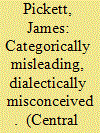

|
|
|
|
|
| Summary/Abstract |
Persian language manuals uniformly adopt national categories such as Persian/Farsi (Iran), Dari (Afghanistan) and Tajik (Tajikistan). These categories at once impose an imagined contrast between the languages at the high register that is in fact marginal, while occluding profound linguistic variation within these nation-states at colloquial registers. Similar schemas apply to Central Asian Turkic languages such as Uyghur and Uzbek, which are closely related at the formal/literary register, but regionally diverse at lower registers. This dominant instructional approach ill prepares language learners for engaging the region on its own terms, rather than through the lens of nationalist aspirations. Students would be better served by an integrative method that teaches a transnational high language (in the case of Persian) while introducing a diverse range of dialects.
|
|
|
|
|
|
|
|
|
|
|
|
|
|
|
|
| 2 |
ID:
156107
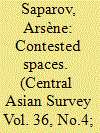

|
|
|
|
|
| Summary/Abstract |
This article deals with the political manipulation of symbolic landscape, using post-Soviet Azerbaijan as a case study. In particular, it looks at the practice of toponym changes as an element of political legitimization and national identity-making. The political use and manipulation of place-names and symbolic landscape is a relatively recent phenomenon that became particularly widespread in the twentieth century. It is widely used for ideological or nationalist purposes throughout the world – from Iran to Israel, from former Yugoslavia to the USSR. However, I argue that post-Soviet Azerbaijan represents an unusual case where one can clearly see strikingly different patterns of place-name manipulation in the pursuit of political legitimacy. It argues that while questions of political legitimacy and nationalism found their reflection in the policy of place-name manipulation, their uses followed clearly different routes and were confined to separate areas.
|
|
|
|
|
|
|
|
|
|
|
|
|
|
|
|
| 3 |
ID:
156105
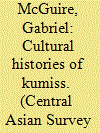

|
|
|
|
|
| Summary/Abstract |
In the nineteenth century, European doctors began to credit kumiss (fermented mare’s milk) for the apparent absence of tuberculosis among the nomads of the Eurasian steppe. As European and American medical journals published articles on the ‘kumiss cure’ and Russian doctors opened kumiss sanatoria, praise for the drink’s curative powers was wound together with romanticized images of the nomadic pastoralists whose creation it was. In Soviet and now in post-Soviet Kazakhstan, kumiss came to hold the double status of medicine and of national heritage. Yet if in the nineteenth century, the steppe was notable for the absence of tuberculosis, in the late twentieth century, it is notable for its presence: Kazakhstan, like many post-Soviet countries, is currently the site of an epidemic of drug-resistant tuberculosis. Discussions of the epidemic now tangle together concerns over the physical health of the population with concern over the cultural health of the body politic.
|
|
|
|
|
|
|
|
|
|
|
|
|
|
|
|
| 4 |
ID:
156106
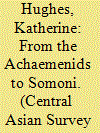

|
|
|
|
|
| Summary/Abstract |
This article focuses on the iconicity of contemporary Dushanbe’s capitol complex, with its state-sponsored architecture and memorial culture, part of the government of Tajikistan’s national identity construction. Dushanbe’s architecture post-independence is actant, a mnemonic and iconographical bridge between the present and favoured historical periods in a quest for national origins. A bricolage of historical symbols, including those of Achaemenid Iran and the early Islamic Samanids, is displayed here in a city with Soviet foundations. Together with pan-Iranian iconography is a desire by the government of Tajikistan for monumentality for its own sake. The capitol complex evokes the natural world, connected to a Central Asian conception of sacred space, suggesting an interlacing of power and religious authority. These monumental building projects are taking place against the backdrop of the destruction of Dushanbe’s ‘authentic’ Soviet architecture and built heritage in the capitol complex, itself a container for collective memory.
|
|
|
|
|
|
|
|
|
|
|
|
|
|
|
|
| 5 |
ID:
156102


|
|
|
|
|
| Summary/Abstract |
What would a ‘good’ industrial policy in the realm of cotton production look like? This article seeks to address this question through a focus on reforms to the cotton sector in Kazakhstan. In contrast with neighbouring Uzbekistan and Turkmenistan, administrators in Kazakhstan had widely freed the cotton sector from government control as early as 1998. Agricultural collectives had been replaced by small private farms, and commercial cotton processors and traders entered the sector. However, in 2007, regulation tightened again and forced ginneries to use a complex warehouse receipt system without making sure that it was accepted by stakeholders and without appropriate institutions for implementing it in place. Moreover, it imposed financing restrictions on ginneries, which were major loan and input providers to farmers. In the following years, private producers and investors turned away from cotton, and cotton area and output fell substantially. We position our analysis in the broader debate about the right approach to industrial policy and argue that the cotton sector performance after 2007 shows how ill-designed regulation and government interference can turn a promising economic sector towards decline.
|
|
|
|
|
|
|
|
|
|
|
|
|
|
|
|
| 6 |
ID:
156104
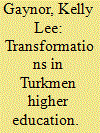

|
|
|
|
|
| Summary/Abstract |
This article consists of two major parts. It begins with a brief summary of the philosophy and history of higher education in Turkmenistan since its independence in 1991. This discussion is based on available mass media accounts and existing research. It also provides some regional comparisons between the Republic of Turkmenistan and its Central Asian neighbours. This part concludes with a description of the current Turkmen higher education landscape. The second part uses an ethnographic case-study approach to describe daily organizational, academic and cultural life, a ‘sense of place’, at one of the several higher education institutions in Turkmenistan which is a pioneer in trying to globalize the system. The case study is particularly focused on changes and challenges associated with moving from a traditionally dominated top-down specialist degree towards the bachelor’s and master’s degree programmes and credit-hour system that this institution is attempting to implement.
|
|
|
|
|
|
|
|
|
|
|
|
|
|
|
|
| 7 |
ID:
156101


|
|
|
|
|
| Summary/Abstract |
In December 2015, leaders from Central and South Asia took part in the ground-breaking ceremony for the Turkmenistan-Afghanistan-Pakistan-India (TAPI) natural gas pipeline project. Sixteen months later, a confusing information flow continues to obfuscate external assessments of the project’s development: official rhetoric notwithstanding, there is no certainty on the details of project financing, while the pipeline route has yet to be determined. To illuminate this obscure implementation path, this article regards TAPI as a virtual pipeline, an infrastructure project that wields invaluable influence only when it is employed as a foreign policy tool or permeates domestic discourses of progress framed by the elites of the four consortium partners. The constituent elements of TAPI virtuality are discussed here through a dedicated focus on the process of energy policy-making of Turkmenistan – the sole supplier of gas for the pipeline project and the consortium’s key stakeholder.
|
|
|
|
|
|
|
|
|
|
|
|
|
|
|
|
| 8 |
ID:
156103


|
|
|
|
|
| Summary/Abstract |
This article examines whether and to what extent China’s involvement in Central Asian countries undermines the democracy promotion efforts of the European Union and the United States. Findings confirm that China does indeed challenge Western efforts, but in an indirect way. First, Chinese provision of substantial and unconditional financial assistance makes Western politically conditioned aid appear both ungenerous and an infringement of sovereignty. Second, the Shanghai Co-operation Organisation, inclusive of China’s leadership role, creates an institutional means through which the (semi-)authoritarianism of member states is legitimized and challenges Western emphasis on democracy and human rights. Finally, by the power of its own example, China demonstrates that democracy is not a prerequisite for prosperity, the rule of law and social well-being.
|
|
|
|
|
|
|
|
|
|
|
|
|
|
|
|
|
|
|
|
|